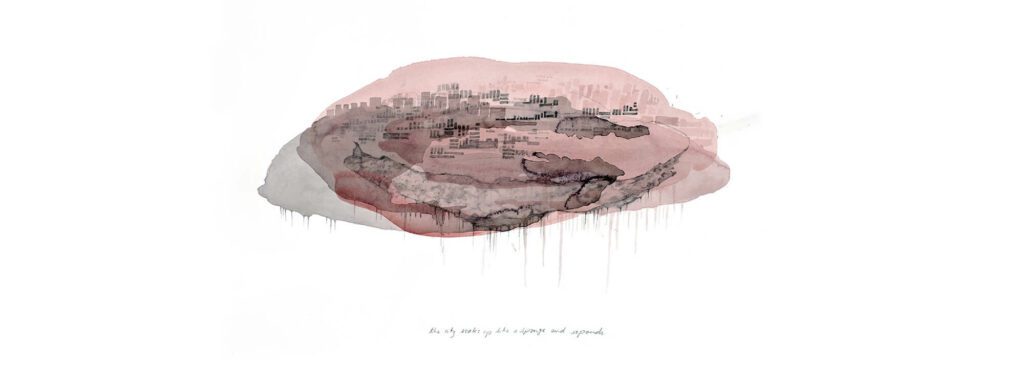The Africa Institute, Sharjah, United Arab Emirates
14 Dec 2023 - 16 Dec 2023

Naiza Khan, The City Soaks Up Like a Sponge and Expands, 2011. Ink and Watercolour on Arches. Photographer: Mehmood Ali
The Africa Institute presents its third symposium as part of its four-part season titled Colorful Threads: The Interwoven Worlds of Art and Culture in the Western Indian Ocean, scheduled to be held in Sharjah between December 14-16, 2023.
This symposium is co-organized by Prita Meier, Associate Professor of Art History at New York University, and Laura Fair, Professor of African History in the Department of Middle Eastern, South Asian and African Studies at Columbia University.
Colorful Threads: The Interwoven Worlds of Art and Culture in the Western Indian Ocean aims to revolve around the Islands of the Western Indian Ocean region, stretching from the Eastern African coasts of Kenya, Mozambique, Somalia, South Africa, and Tanzania to Comoros, Madagascar, Mauritius, Seychelles, Mayotte, and Reunion, brim with historical, socio-cultural, and economic significances. The circuitous toing and froing across the sea that brought people from the Indian Ocean’s vast expanse had spawned momentous cultural interactions and microeconomies of exchange. Of the various forms of anthropological knowledge about independent invention, innovation, diffusion, and cultural brokerage, we come to understand that these Islands were/are not only creole entities but also important sites of creativity and imagination as evidenced in both symbolic and material cultures such as those expressed in the diversity of languages, ethnicities, rites, performances among other artistic forms of human expressions.
Nowhere have the influences of the Indian Ocean circularities been more powerfully pronounced than in the aesthetic realms of art and cultural production. The predictable monsoon winds that molded the very character of social life in the African Islands of the Indian Ocean were both ethnographically and historically significant for the communities in question. A plethora of patterns and processes through which artistic and cultural knowledge traveling from the various shores of the ocean’s rim had come to be shared, practiced, and revered, reveals a fecund cosmological imagination and inventiveness. Taking notice of the impressive artistic genius and cultural vibrancy of the people of the Western Indian Ocean, galleries and curators throughout North America, Australia, and Europe brought some of the most notable traditions to the broader public as had some museums of archeology and anthropology. The exhibitions of Madagascar’s stunning akotifahana colorful textiles, which were once worn by the local elites and offered to dignitaries as gifts were put on full display in the Royal Ontario Museum. Similar exhibitions that differed in scope and scale have analogously imparted considerable knowledge on the numerous cultural objects’ provenances and histories abound. The series arranged by the Institute of Contemporary Art (ICA) exhibit Arts of the Monsoon is one example that drew attention to the Island’s opulent artistic resources.
From the vast array of the rich artistic traditions of music, photography, theatre, dance, ritual life, and spirit possession performances to mention a few, this symposium’s angle on art and cultural production will pivot around key subjects of critical importance to scholars in the humanities and the social sciences. By deciphering the fine print of this intricately interwoven oceanic tapestry, we examine the ways in which this artistry has shaped the Islanders’ subjectivities both cosmologically and culturally. Our focus on aesthetic sensibilities and cultural logic is an effort to broaden the scope of the archipelagic identities and the patterns of self-fashioning, which were brought about by the systematic human convergences on the Islands. Our interpretive frames of such patterns will be contextualized within larger epistemological questions of the conditions under which such fusions occurred. This by necessity will engage questions of power, representation, production, consumption, and the systems of signification emerging from a panoply of cultural forms and consciousnesses. This theme, Colorful Threads: The Interwoven Worlds of Art and Culture in the Western Indian Ocean thus strives to examine such currents by taking a closer look at the multitude of styles, meanings, experiences, and performances in an ocean that Julia and Markus Verne have aptly called an “aesthetic space.”
This forum will bring scholars from various academic disciplines and geographical locations to ponder what Pierre Bourdieu made clear in his distinctions as both symbolic and cultural capital. Our focus on rethinking the archipelago will improve our understanding of the fine-grained nuances of human relations. The vantage points of anthropology, history, art, architecture, museum studies, ethnographies of rituals, music, and dance as conceived within disciplinary and interdisciplinary knowledge and practice will be engaged fully in presentations, symposia, and publications.
The season is part of its annual Country-focused Season themed, Thinking the Archipelago: Africa’s Indian Ocean Islands convened by The Africa Institute in collaboration with leading scholars namely Jeremy Prestholdt, Professor of History at the University of California, San Diego; Rogaia Mustafa Abusharaf, Professor of Anthropology, Georgetown University in Qatar; and Uday Chandra, Assistant Professor of Government, Georgetown University, in Qatar.
The country-focused season is free and open to public. Livestream of the conference is available on our Youtube page.